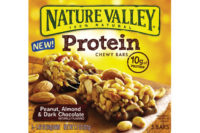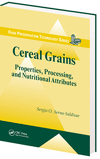Bars’ Stars






However, Mintel suggests otherwise. In fact, according to that research group, the category’s heyday would appear to be behind it, judging purely by sales growth data. Between 2009-2011, the market grew 4.9%; however, in 2010-2011, sales were essentially flat, Mintel found—possibly an indication that consumers are seeking other breakfast and snacking options. As such, manufacturers are responding with a host of innovative new cereal bars that attempt to capitalize on any of a number of the industry’s leading trends.
Fibers of Truth
Fiber enrichment has been at the forefront of consumer demands for years. Even Target’s private label has joined the fiber-enriched bar segment, with Market Pantry Fiber Bars in oats and strawberry with almonds; oats and caramel; oats and peanut butter; and fruit and nut varieties. Similarly, Shaklee Corp.’s own brand has introduced Fiber Advantage Chewy Apple Cinnamon Bars made with fruit, vegetables and whole grains; this one, however, is free of gluten, artificial flavors, sweeteners, colors and preservatives.
Mars has entered bar territory, capitalizing on the success of its Snickers brand in Marathon energy bars. The company has now added a Crunchy Trail Mix Bar under Marathon’s Smart Stuff sub-brand. Featuring blueberries, cranberries, chocolate and peanuts, each 140-calorie bar boasts a blend of eight essential vitamins and minerals and is an excellent source of calcium, plus 5g of whole grains and no high-fructose corn syrup (HFCS), artificial colors, flavors or sweeteners.
Clif Bar has been something of a stalwart in the bar segment, and recent launches have seen the company add a high-protein option and one geared more toward young consumers. Clif Builders brand added a Chocolate Mint Natural Protein Bar, with each kosher-certified bar containing 20g of whole protein and a low glycemic index. Its Clif Kid Crispy Rice ZBar brand debuted a Chocolate Whole Grain Rice Crispy Bar, with whole grains, no HFCS and promising to be an excellent source of calcium.
Under its Fiber One brands, General Mills added a fiber boost to a host of products geared toward adult palates. However, its latest take on the notion is oriented more to young people. It is adding Fiber One Chewy Bars in Chocolate and Strawberry PB&J varieties. While the goal is to entice children with the flavors, parents are firmly the target behind the bars’ nutrition profile: Each bar has 110 calories or less, 8g or less of sugar, 20% of the daily recommended value of fiber and no HFCS.
General Mills has announced its growth plans for fiscal year 2013, and some 70 new product launches in the first half of the year, alone, are at the heart of the agenda. One of its key categories will be snack bars.
“Our future growth plans remain focused on five global categories—ready-to-eat cereal, super-premium ice cream, convenient meals, wholesome snack bars and yogurt,” said Chris O’Leary, executive vice president, chief operating officer, International. “In fiscal 2013, we want to generate growth in our core, developed markets, while expanding our presence in emerging markets worldwide.”
Unsurprisingly, the Kellog Company has similar notions in mind, when it comes to expanding its stalwart brands in the cereal bar segment. Its Special K brand is adding Pastry Crisps. The two varieties—Chocolaty Delight and Brown Sugar Cinnamon—promise 100 calories per serving. At the same time, the company has opted to re-launch Special K protein cereal, “in response to consumers looking for protein for energy and to feel full longer.” In addition, Kellogg plans to add FiberPlus Nutty Delight bars in Peanut & Dark Chocolate and Honey Roasted Almond versions.
Fiber has been at the heart of bars promising to help manage weight, with “high satiety” an increasingly frequent claim on packages. Fullbar, while it does boast 5g of fiber and 5g of protein, is described as a pre-meal bar that will help the consumer feel full and consume less at mealtimes. However, that satiety promise is not exclusively due to the presence of fiber.
Fullbar’s package notes it is “Clinically proven to help lose weight,” and it bears a “Now with All-natural Hunger Block” label. That all-natural hunger blocker is a potato protein extract that promises to minimize feelings of hunger between meals. The active component is Proteinase Inhibitor II, a natural protein found just under the skin of the potato that promises to promote satiety by enhancing “the body’s natural release of cholecystokinin.”
Fullbar is among the many examples of the move toward protein content in helping consumers manage their weight and, in general, improve their overall health. Special K has added a Protein Meal Bar, promising 10g of protein and 5g of fiber, in such varieties as chocolate peanut, chocolatey chip and chocolate delight.
Back to Nature
Under its Nature Valley label, General Mills has added a Protein variety, with each bar providing 10g of protein per bar. Varieties include a peanut butter and dark chocolate option, as well as one that adds almond to that pairing. That Nature Valley brand has drawn criticism and even a lawsuit, however. The Center for Science in the Public Interest (CSPI) filed the suit, accusing the snack maker of “going to great length[s] to market its granola bars and ‘thins’ as ‘natural,’ even though they contain industrially produced artificial ingredients.” The complaint notes high-maltose corn syrup and/or maltodextrin are in dozens of the Nature Valley-branded products. The CSPI notes neither high-maltose corn syrup nor maltodextrin appear in nature and “not even under the most elastic possible definition could they be considered ‘natural.’”
Fiber-enriched satiety, however, is far from the only route to weight control. For that matter, portion control has long been a concern, even for consumers of products that promise to help with managing weight. ThinkThin is one example of a product that has shrunk the bar size, but at the same time capitalized on that fact by noting each bar now has only 100 calories. Its gluten-free bars also boast 6g of protein and 0g of sugar, and are certified-kosher.
While new and innovative sweetening agents have been the means to weight management across a range of other categories, these have been somewhat less prominent in cereal bars. A couple of notable exceptions, however, have incorporated versions of stevia. Access Business Group’s Nutrilite Protein Bars are sweetened with rebiana and promise 21g of protein and 1g of sugar. The Nutrilite line includes such varieties as Chocolate Delight, Cinnamon Bun, Lemon Twist, Blueberry Crunch, Cherry Almond, Cranberry Crunch and Caramel Crème, to name only a few.
Balance Bar Company’s Nimble bar is similarly sweetened with a stevia variety; the bar targets women consumers and promises 120 calories. Balance Bar Co. notes it has maintained a 40-30-30 principle for its range of products, including its recent 100-calorie, mini-energy bars: 40% of calories come from healthy carbohydrates; 30% from quality protein; and 30% from dietary fat. The mini-energy bars, found in cookie dough and double-chocolate brownie varieties, contain 7g of protein and 23 vitamins and minerals, plus serve as an “excellent source” of vitamins A, C and E.
Fiber has clearly become less of a distinguishing factor among cereal bars. For that matter, cereal bar brands have distinguished themselves further by noting their antioxidant content and boasting of inclusions with a healthy aura. Under its Nutri-Grain label, for example, Kellogg has added Superfruit Fusion varieties, with such flavors as strawberry açai promising antioxidant vitamins C and E. In fact, fiber enrichment would appear to be a cost of entry into the segment and an expectation of consumers. Those consumers are now seeking additional boosts from their cereal bars, be it in the form of added protein, omega-3s, or assorted vitamins and minerals. pf
Looking for a reprint of this article?
From high-res PDFs to custom plaques, order your copy today!








